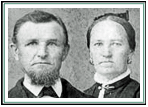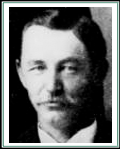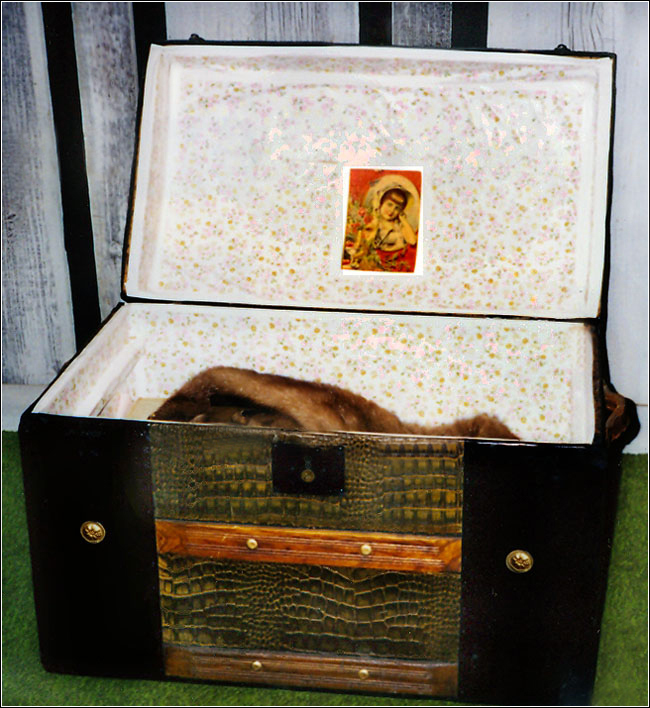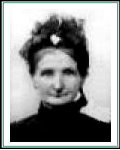|
 Ralph Heiden - I also have some papers here from the German government that gives
August and his family permission to leave Germany. It is for
August
and his wife, Rika, and three children,
Heinrich,
Ernst and a little girl,
Meta. Ralph Heiden - I also have some papers here from the German government that gives
August and his family permission to leave Germany. It is for
August
and his wife, Rika, and three children,
Heinrich,
Ernst and a little girl,
Meta. Helma (Heiden) Nickel - Meta was the one that died on the ship on the way over.
August and his family arrived about a year before
William was born
on April 1, 1874.
Jeanie & Wilma (Heiden) Bicking - We always heard that she died on the boat and was
buried at sea.
Ralph Heiden - Unfortunately, the shipís records do not show that
happening. Normally, if someone died on the ship, that would be
noted and there is nothing on the list to indicate that Meta died on
ship.
The shipís list that I have shows August Heiden's age 34, a mason.
Norma "Jeanie" Heiden - A mason? Oh, you mean a
bricklayer, not a member of the
Masons.
Ralph Heiden - Yes. It also lists Rika, 31, his wife, Herman, 6 years old,
male, Ernst, 4 years old, a male, his children, and Meta, 9 months,
his baby.
 Helma (Heiden) Nickel -
Herman? That should be Henry. Helma (Heiden) Nickel -
Herman? That should be Henry.
Ralph Heiden - Youíre right, it is
Heinrich
(right). But there was no mention of
anyone buried at sea.
Wilma (Heiden) Bicking - We all heard the story that a baby was buried at sea.
Ralph Heiden - That would seem logical since there doesnít appear to be a
record of her here in Michigan. At least not that I have found so
far.
(Note:
Later research discovered that
Meta made it to America but
died on June 16, 1873 only 12 days after they arrived from
Germany. She is buried at the Zion Lutheran Church cemetery
in Monroe, Michigan.)
Norma "Jeanie" Heiden - Maís grandmother,
Miller
(or MŁller), died in Germany before they came
over to America. According to Ma, she was old anyway and did not
know for sure if she wanted to come over here. Of course, thatís the
Rambowís side.
Wilma (Heiden) Bicking - August landed in New York? How did they get to Monroe?
 Norma "Jeanie" Heiden - Normally, they had someone over here sponsor them. Norma "Jeanie" Heiden - Normally, they had someone over here sponsor them.
Wilma (Heiden) Bicking - Did the Rambows come on the same ship?
Helma (Heiden) Nickel - The Rambows and
Milhans came over about the same time.
[Note: The Rambows came to America in 1874, one year after the Heidens.]
Wilma (Heiden) Bicking - It seems that they all came over about the same time because
they knew somebody here. Iíve also got the cedar chest that Maís mother brought over from
Germany. Ma used it as a hope chest.
Ralph Heiden - When I got the ship list originally, back in 1974, I
contacted a lady in Washington D.C. who, for a fee, looked it up in
the National Archives.
Now, there are some books that list all the ship logs for the
mid-1800's that left Germany for the U.S. I contacted a person on
the computer network, Prodigy, and they looked it up for me and
found the same information that appears on the information I had. They also found at least one other Heiden that came over on the ship
but I did not recognize the name.
Norma "Jeanie" Heiden - Did
August Heiden have any brothers?
Ralph Heiden - Not from what I could find out. He did have a half-sister,
however.
One of the other things that I got from
Aunt Agnes was a
bunch of
letters from Germany to August and Rika (Knaack) Heiden back in the 1920's.
Most of them were signed from a Maria Dohmstrich from
Rostock,
Germany. That is only about 30 or 40 miles away from the little
towns where our ancestors lived.
 On some of the letters she adds ďgeb. SchmidtĒ after her name which
means that her maiden name was Schmidt. Well, it seems that
Augustís
half sister (left) married a man named Schmidt and had a daughter,
Maria. On some of the letters she adds ďgeb. SchmidtĒ after her name which
means that her maiden name was Schmidt. Well, it seems that
Augustís
half sister (left) married a man named Schmidt and had a daughter,
Maria. So, the letters are from Augustís half-sisterís daughter. His niece.
She was born in 1866 so she would have been in her sixties at the
time the letters were written. My great-grandmother, Rika, must have sent them the occasional five
dollars. That was a huge amount back then because of the inflation
going on in Germany at the time. They really appreciated it.
Wilma (Heiden) Bicking - I didnít know that her grandma was a
Knaack.
Jeanie & Helma (Heiden) Nickel - Yes, she was.
Wilma (Heiden) Bicking - So,
Maria Heiden never married
Kannseyer?
Ralph Heiden - No, and who knows why. From what Iíve read, they were having
a population problem in Germany so they made it very difficult for
people to get married. But, people being what we are, they went
ahead and had children anyway. A very large percentage of the births
during the mid-1800's were out of wedlock.
But they never did get married. When she died in 1874, she was
still listed as Maria Heiden. Wilma (Heiden) Bicking - So, how many children did she have?
Ralph Heiden - Just the two as far as I know. August in 1838 and the
daughter,
Fredericka, in 1832. She was the mother of the one who
wrote the letters.
|



